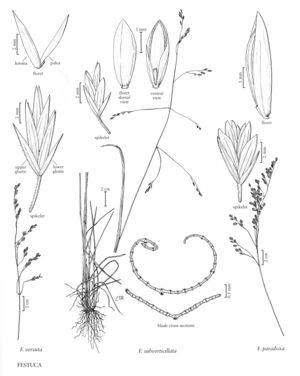Difference between revisions of "Festuca paradoxa"
FNA>Volume Importer |
FNA>Volume Importer |
(No difference)
| |
Revision as of 19:16, 24 September 2019
Plants loosely cespitose, with¬out rhizomes. Culms 50-120 cm, glabrous. Sheaths closed for less than 1/3 their length, glab¬rous, shredding into fibers; Iigules (0.2)0.5-1.5 mm; blades 2-8 mm wide, flat or loosely convolute, smooth or scabrous, veins 9-35, ribs obscure; abaxial sclerenchyma in narrow strands; adaxial sclerenchyma developed; girders or pillars usually associated with the major veins. Inflorescences (5)10-20 cm, open, with 1-2 branches per node; branches lax, ascending to spreading, spikelets clustered towards the ends of the branches, closely imbricate. Spikelets 4-7(7.5) mm, elliptic to obovate, with 3-5(8) florets. Glumes lanceolate to ovate-lanceolate, scabrous at least on the veins; lower glumes (2.5)3-4(5) mm, usually almost as long as the adjacent lemmas; upper glumes (3.5)4-5(5.5) mm; lemmas 4-5(5.2) mm, stiffly chartaceous, ovate to obovate, glabrous, somewhat acute, unawned; paleas as long as or slightly shorter than the lemmas, intercostal region smooth or scabrous distally; anthers (0.7)1-2(2.5) mm; ovary apices pubescent. 2n = unknown.
Distribution
Kans., Nebr., Okla., Minn., Md., Miss., Tex., La., Pa., Mo., Del., Ala., Wis., Ont., Que., N.C., S.C., Va., Ark., Ill., Ga., Ind., Iowa, Ky., Tenn.
Discussion
Festuca paradoxa grows in prairies, open woods, thickets, and low open ground, from Wisconsin to Pennsylvania, south to northeastern Texas and northern Georgia. It resembles F. subverticillata (see previous), but its spikelets are more crowded on the branches.
Selected References
None.
